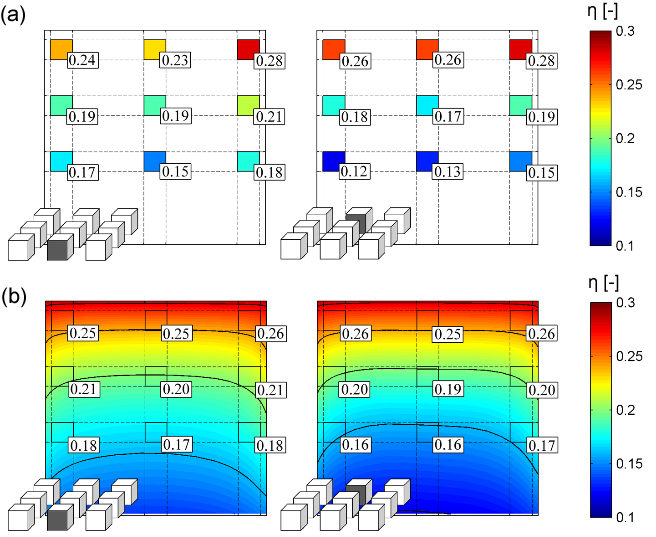Wind driven rain model
Wind-driven rain (WDR) has impact on the durability of urban materials, the urban microclimate and the urban thermal comfort. We use CFD to obtain accurate and detailed spatial and temporal distributions of wind-driven rain on the built environment. Our wind-driven rain model is based on an Eulerian formulation for separate rain phases (each for a different range of raindrop size) and is validated with different field measurements.
Wind-driven rain has impact on the durability of urban materials, the urban microclimate and the thermal comfort. CFD simulations can be used to obtain accurate and detailed spatial and temporal distribution of wind-driven rain. Wind-driven rain model based on a Eulerian Multiphase (EM) formulation for separate rain phases (each for a different range of raindrop size) is validated with field measurements. While Lagrangian particle tracking for WDR is still computationally too intensive, the EM offers the possibility to study in an efficient way the distribution of WDR intensity on complex urban configurations. Such a WDR model allows to predict the rain load on all urban surfaces including roofs, facades, pavements, streets, and building details such as roof overhangs, balconies and window sills.
The solver developed for the finite volume code OpenFOAM, windDrivenRainFoam, is made available in the section Downloads

Findings show that the patterns of surface wetting due to wind-driven rain are influenced by the arrangement of buildings, façade details on buildings and atmospheric conditions, i.e. rainfall intensity, wind speed, wind direction.
Publications
Derome D, Kubilay A, Defraeye T, Blocken B, Carmeliet J. 2017. Ten questions concerning modeling of wind-driven rain in the built environment. Building and Environment; 114:495–506.
Kubilay A, Derome D, Carmeliet J. 2017. Analysis of time-resolved wind-driven rain on an array of low-rise cubic buildings using large eddy simulation and an Eulerian multiphase model. Building and Environment; 114:68-81.
Kubilay A, Carmeliet J, Derome D. 2017. Computational fluid dynamics simulations of wind-driven rain on a mid-rise residential building with various types of facade details. Journal of Building Performance Simulation; 10(2):125-143.
Kubilay A, Derome D, Blocken B, Carmeliet J. 2015. Wind-driven rain on two parallel wide buildings: field measurements and CFD simulations. Journal of Wind Engineering & Industrial Aerodynamics; 146:11-28.
Kubilay A, Derome D, Blocken B, Carmeliet J. 2015. Numerical modeling of turbulent dispersion for wind-driven rain on building facades. Environmental Fluid Mechanics; 15(1):109-133.
Kubilay A, Derome D, Blocken B, Carmeliet J. 2014. Numerical simulations of wind-driven rain on an array of low-rise cubic buildings and validation by field measurements. Building and Environment; 81:283-295.
Kubilay A, Derome D, Blocken B, Carmeliet J. 2014. High-resolution field measurements of wind-driven rain on an array of low-rise cubic buildings. Building and Environment; 78:1-13.
Kubilay A, Derome D, Blocken B, Carmeliet J. 2013. CFD simulation and validation of wind-driven rain on a building facade with a Eulerian multiphase model. Building and Environment; 61:69-81.
